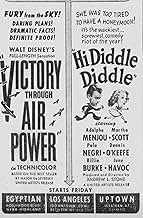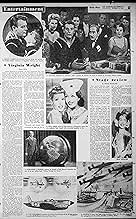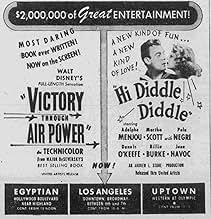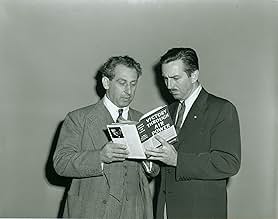VALUTAZIONE IMDb
6,4/10
1314
LA TUA VALUTAZIONE
Aggiungi una trama nella tua linguaAn animated documentary promoting of the soundness of strategic aerial bombing in World War II.An animated documentary promoting of the soundness of strategic aerial bombing in World War II.An animated documentary promoting of the soundness of strategic aerial bombing in World War II.
- Candidato a 1 Oscar
- 2 vittorie e 1 candidatura in totale
Alexander de Seversky
- Self
- (as Major Alexander P. de Seversky)
Art Baker
- Self - Narrator
- (voce)
Billy Mitchell
- Self
- (filmato d'archivio)
Recensioni in evidenza
Based on the book by Major Alexander de Seversky published in 1941, this film is basically Disney's vehicle for pressing De Seversky's military plan upon Roosevelt, Churchill and the people of America and Britain. De Seversky argued that we should use bombers to attack Axis factories, farms, lines of transportation and resources. Basically, he argued that America and England should begin killing civilians by the tens of millions. And it's a Disney film.
After a brief homage to General Billy Mitchell, the first major animated sequence of the film you've probably seen: "History of Aviation." It starts with the Wright Brothers at Kitty Hawk, and documents the beginning of flight. It then moves on to the formation of the American Air Corps in 1908, early achievements in flight. It shows how aircraft were used in World War I, with the first surveillance planes, the first fighters and the first bombers.
The film moves on to give a history of World War II up to that point, but there are several factual errors, including a sequence where the German Army uses air cover and tanks to break the Maginot Line. In reality, Germany simply invaded France through Belgium. It shows that the invasion of Crete was a great victory for Germany, while it was actually a disaster that nearly failed.
The film then goes on to describe America's role in the war, describing America as the "Arsenal of Democracy." It argues that since American supply lines are thousands and thousands of miles long and German/Japanese supply lines are very short, Japan and Germany have a decided advantage over us. The solution? Stop attacking Hitler's tanks and soldiers, and begin attacking the factories, farms, workers and farmers which build those tanks and feed those soldiers.
The film has a decidedly unsettling tone about it. It begins as a typical Walt Disney cartoon documentary, light-hearted and funny, but it ends describing some of the most disturbing tactics of modern combat, such as blowing up dams to flood the enemy, and employing bombs that will cause earthquakes, perhaps a metaphor for nuclear weapons. It's definitely not for children.
The version found on The Disney Treasures set "On the Front Lines" is only 65 minutes long, and doesn't have the scene that argues that America is the greatest nation for aviators by insulting every nation in Europe, including our allies, France and Britain.
After a brief homage to General Billy Mitchell, the first major animated sequence of the film you've probably seen: "History of Aviation." It starts with the Wright Brothers at Kitty Hawk, and documents the beginning of flight. It then moves on to the formation of the American Air Corps in 1908, early achievements in flight. It shows how aircraft were used in World War I, with the first surveillance planes, the first fighters and the first bombers.
The film moves on to give a history of World War II up to that point, but there are several factual errors, including a sequence where the German Army uses air cover and tanks to break the Maginot Line. In reality, Germany simply invaded France through Belgium. It shows that the invasion of Crete was a great victory for Germany, while it was actually a disaster that nearly failed.
The film then goes on to describe America's role in the war, describing America as the "Arsenal of Democracy." It argues that since American supply lines are thousands and thousands of miles long and German/Japanese supply lines are very short, Japan and Germany have a decided advantage over us. The solution? Stop attacking Hitler's tanks and soldiers, and begin attacking the factories, farms, workers and farmers which build those tanks and feed those soldiers.
The film has a decidedly unsettling tone about it. It begins as a typical Walt Disney cartoon documentary, light-hearted and funny, but it ends describing some of the most disturbing tactics of modern combat, such as blowing up dams to flood the enemy, and employing bombs that will cause earthquakes, perhaps a metaphor for nuclear weapons. It's definitely not for children.
The version found on The Disney Treasures set "On the Front Lines" is only 65 minutes long, and doesn't have the scene that argues that America is the greatest nation for aviators by insulting every nation in Europe, including our allies, France and Britain.
"Victory Through Air Power" is an exceptionally well made film from Disney. It was made to bolster the notion of strategic bombing...bombing factories in Axis territory in order to bring the Japanese and Germans to their knees. It's told first as a history of military aviation and then a film specifically about WWII and the Allied bombing campaign....along with some portions where Major Alexander de Seversky talks about the program and how it will lead to a victory over the Axis.
The film is great for history teachers (like me) and WWII buffs. Others will likely find it slow and uninteresting. But for what it is, it's exceptionally well made...with some amazing animation and a well structured story.
By the way, SOME of the theory presented in the movie is true, some isn't exactly....and this was learned after the war ended. In Europe, despite all the bombing by Allied planes, German production actually INCREASED as the war progressed. What actually won the war in Europe was a combination of things....including Allied raids on German controlled oil refineries as well as the work of the infantry.
The film is great for history teachers (like me) and WWII buffs. Others will likely find it slow and uninteresting. But for what it is, it's exceptionally well made...with some amazing animation and a well structured story.
By the way, SOME of the theory presented in the movie is true, some isn't exactly....and this was learned after the war ended. In Europe, despite all the bombing by Allied planes, German production actually INCREASED as the war progressed. What actually won the war in Europe was a combination of things....including Allied raids on German controlled oil refineries as well as the work of the infantry.
Victory Through Air Power (1943)
*** (out of 4)
With WWII going full strength, everyone in Hollywood did what they could to bring attention and information to the screen and that includes Disney. This animated feature is pretty entertaining in its own right as we learn about the history of aviation and then go into details on how planes are playing a major role in the war.
If you've seen any of the documentaries from this era then you're really not going to learn anything new here. The "Why We Fight" series pretty much covered this stuff in much greater detail but of course the one difference is that this film is animated. The Disney crew really did a terrific job with the animation as it's up to their usual high standards. Fans of Disney will certainly enjoy the animation but WWII buffs will also like the way the documentary shows the bombings at Pearl Harbor and the animated maps on the various issues America faces going up against Japan and Germany.
*** (out of 4)
With WWII going full strength, everyone in Hollywood did what they could to bring attention and information to the screen and that includes Disney. This animated feature is pretty entertaining in its own right as we learn about the history of aviation and then go into details on how planes are playing a major role in the war.
If you've seen any of the documentaries from this era then you're really not going to learn anything new here. The "Why We Fight" series pretty much covered this stuff in much greater detail but of course the one difference is that this film is animated. The Disney crew really did a terrific job with the animation as it's up to their usual high standards. Fans of Disney will certainly enjoy the animation but WWII buffs will also like the way the documentary shows the bombings at Pearl Harbor and the animated maps on the various issues America faces going up against Japan and Germany.
I just watched this feature last night from my copy of "Disney Treasures: On the Front Lines," which is an excellent set with many cartoon shorts, educational films, and propaganda films that are unusual of Disney, but nonetheless retain the same feel as the ordinary Disney short.
Being a pacifist, I think that all people should try to understand warfare for what it is, but try to avoid jumping into war until it is absolutely necessary. WWII was indeed a necessary war to fight, and the film, though not specifically aimed to do so, makes this point very clear.
First, before getting directly into the battles, the film educates us on the history of flight. With cartoon humour and sight gags it comes off very entertaining.
Then, the film is turned over to Alexander de Seversky, author of the book on which the film is based. De Seversky makes a valid point that the war should be fought with an enlarged military air force as opposed to naval and land based tactics. He is made to be very informative and enjoyable to watch against the animated maps and diagrams created by Disney's finest animators.
Eerily, there is a link to the 9/11 happening in the idea de Seversky expresses that air power removes the lines between civilians and soldiers and puts the lives of any of us at risk. It is fortunate that he had not lived to see this sad day.
Being a pacifist, I think that all people should try to understand warfare for what it is, but try to avoid jumping into war until it is absolutely necessary. WWII was indeed a necessary war to fight, and the film, though not specifically aimed to do so, makes this point very clear.
First, before getting directly into the battles, the film educates us on the history of flight. With cartoon humour and sight gags it comes off very entertaining.
Then, the film is turned over to Alexander de Seversky, author of the book on which the film is based. De Seversky makes a valid point that the war should be fought with an enlarged military air force as opposed to naval and land based tactics. He is made to be very informative and enjoyable to watch against the animated maps and diagrams created by Disney's finest animators.
Eerily, there is a link to the 9/11 happening in the idea de Seversky expresses that air power removes the lines between civilians and soldiers and puts the lives of any of us at risk. It is fortunate that he had not lived to see this sad day.
Now that Disney's released the Black Cauldron and Melodytime, that leaves very few Disney films that have never been released on a home video format. In fact, it pretty much leaves this and Song of the South.
I have seen about half of the movie, in bits and pieces, because of Disney's habit of using clips from older animations in newer compilations. Chances are, if you've ever seen Disney animation showing WWII vintage fighters or bombers, you've seen a part of this film.
There's nothing terribly entertaining anymore about Victory- it's as entertaining as any other WWII-era propaganda film. But, given collectors' completist mindset, and given the historical significance of any and all war-era films, I think Disney needs to release this movie; even if it's in an extremely limited mail-order-only release. It needn't come in a clamshell, but Disney owes it to their fans to let them have the opportunity to see ALL of their work.
I have seen about half of the movie, in bits and pieces, because of Disney's habit of using clips from older animations in newer compilations. Chances are, if you've ever seen Disney animation showing WWII vintage fighters or bombers, you've seen a part of this film.
There's nothing terribly entertaining anymore about Victory- it's as entertaining as any other WWII-era propaganda film. But, given collectors' completist mindset, and given the historical significance of any and all war-era films, I think Disney needs to release this movie; even if it's in an extremely limited mail-order-only release. It needn't come in a clamshell, but Disney owes it to their fans to let them have the opportunity to see ALL of their work.
Lo sapevi?
- QuizAfter seeing the movie (at Winston Churchill's urging), Franklin D. Roosevelt finally committed to a full strategic air campaign against Germany.
- BlooperThe film claims the German's used air power to break through the Maginot line to conquer France. In reality, the German forces avoided directly engaging the Line and instead completely circumvented it.
- Citazioni
[first lines]
Billy Mitchell: Today, a war is very different than the last European war was. Now air power is the dominant feature of military operations. Air power can fly directly to the vital centers of an opposing state and neutralize them. It can destroy the cities, it can wreck the aqueducts, it can knock out the lines of communication, it can destroy the food supplies, and make the people helpless to resist.
- ConnessioniEdited into Partita al Massacro (1945)
I più visti
Accedi per valutare e creare un elenco di titoli salvati per ottenere consigli personalizzati
- How long is Victory Through Air Power?Powered by Alexa
Dettagli
Botteghino
- Budget
- 788.000 USD (previsto)
- Tempo di esecuzione
- 1h 10min(70 min)
- Colore
- Proporzioni
- 1.37 : 1
Contribuisci a questa pagina
Suggerisci una modifica o aggiungi i contenuti mancanti






















